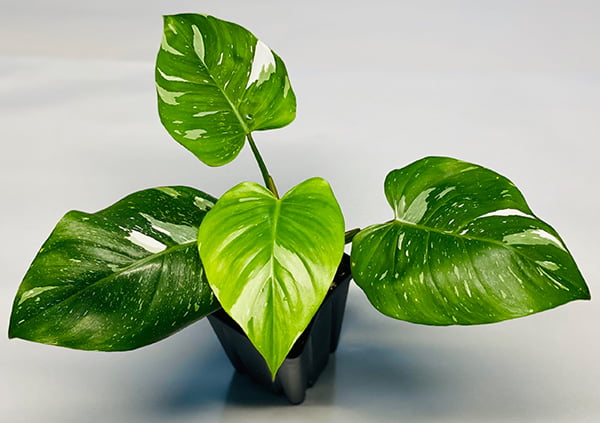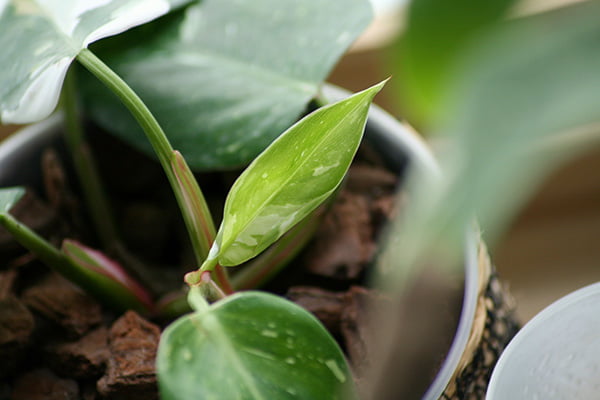Tired of houseplants that are just plain green leaves? The Philodendron white princess will definitely shake things up! And if you are into an exotic and rare plant, you are in luck! The stunning foliage of deep green with white variegation, this beauty is a real looker. Like the sister plant Philodendron pink princess, the Philodendron white princess's unique coloring has placed it on many wish lists within the plant world, and that's caused the price tag to bump up.
Is the Philodendron white princess easy to care for as an indoor plant? How do you keep them white? What are Philodendron white princess care needs? Here is everything you'll need to know to care for it well and help it thrive.
Botanical Name
Common Name
Plant Type
Mature Size
Sun Requirement
Soil Type
Hardiness Zone
Pet Friendly
Philodendron erubescens
White Princess
Tropical
3 Feet tall with 1-2 feet spread
Bright indirect sunlight
Well drained mix
10-13
No
What Are White Princess Philodendrons?
White princess philodendron plants are a rare, highly sought-after among houseplant lovers! Native to South America, they are tropical plants with unique white coloring with reddish pink edges on bright green stems!
The Philodendron white princess is a slow grower due to its variegation, even under the best conditions. Philodendron white princess is a self-heading plant rather than a sprawling vine, and this means the white princess will maintain its fairly compact shape without much pruning or supporting poles. Like many other philodendron varieties, white princesses have both underground and aerial roots available, enabling the plant to get nutrients both ways. When it matures, it will reach up to 3 feet tall and 1-2 feet wide.
To the untrained eye, the Philodendron white Princess, Philodendron white knight, and Philodendron white wizard all look very similar. It may even be hard to distinguish them. To identify them, you will need to know the difference between them, and knowing what to look for is critical.
White Princess Philodendron Care Requirements
Light
Like all tropical plants, the white princess Philodendron needs lots of bright, indirect light. Think of its native habitat, growing under the canopy of larger plants in a rainforest. The ambient light is intense, but little of it directly hits the lower plants.
To mimic this at home, place your white princess Philodendron in a location with lots of indirect sunlight. This could be a room with a west or south-facing window, which lets enough light into the room - just be careful that your plant isn't getting hit with direct sunlight from that window! Another option is placing it directly in an east-facing window. Although it will receive direct light, it will be the softer morning light.
If your white princess leaves don't receive enough sunlight, they will lose their variegation. This is because the white parts of the leaves don't contain chlorophyll. The plant will prioritize the leaf surface with chlorophyll when sunlight is scarce. If your plant appears to be losing its white leaves, give it more light! Many growers advise purchasing a grow light for this plant, especially for a household that doesn't get enough light.
Water
It's important not to overwater your Philodendron white princess. Always let the soil dry out before watering. You can check this by sticking a finger down into the soil, about an inch or two. If you feel moisture, don't water it. When it is time to water, give your plant a thorough drenching! Water it until the excess water flows out of the drainage holes in the bottom of the pot. Leave it in a sink for ten minutes or so until the excess water has fully drained out, and then return it to its home location.
Temperature
The Philodendron white princess does best with indoor temperatures between 60 and 85 degrees Fahrenheit. Warm temperatures with high humidity are the ideal growing environment.
White princess Philodendron can survive temperatures down to 55 degrees Fahrenheit but will go dormant if these cooler temperatures are sustained for long. Take care to keep your white princess away from places where the temperature might be higher or lower than the entire room - such as drafty windows, heating and cooling vents, or fireplaces.
Humidity
The Philodendron white princess needs humidity levels of at least 50%. Your home may reach that air moisture level at some point in the year, but likely not in the winter, and maybe not at all! Thankfully, there are ways to boost the humidity around your plant.

Source: Flickr
Humidifier
Use a small humidifier near your white princess Philodendron.
Grouping
By grouping plants together, the plants naturally increase the moisture in the air around them. So by grouping plants together, you'll create a small humid microclimate.
Place In Bathroom
Place your white princess Philodendron in the bathroom, where regular use of the bath or shower will create a humid environment.
Set your plant on a pebble tray
As the water in the tray evaporates, it will increase the moisture in the air around it. Just be sure that the water in the tray doesn't come up over the top of the pebbles!
Soil
The Philodendron white princess needs loose soil that drains quickly. There are soil mixes specially formulated for philodendrons, but you can easily make one yourself. Mix a standard potting soil with perlite, peat moss, and orchid bark. A well-draining soil will be two parts aeration to 1 part soil.
Fertilization
While the white princess Philodendron doesn't typically need any fertilizer, giving it these extra nutrients during its growing season (spring and summer) will be helpful.
Use a balanced liquid fertilizer, diluted to half strength, once a month. After fertilizing, water the soil well so that the fertilizer travels all through the soil mix and doesn't stay on top. This also prevents fertilizer burn.
Pruning
If you'd like your Philodendron white princess to trail less and grow bushy, you can achieve this through pruning. In the spring, cut the vines between root nodes.
You can also use pruning to direct your plant's variegation. Typically, each new leaf will mimic the variegation pattern of the leaf directly below it. If your top leaves are more green than you'd like, cut them back to the node directly above a variegated leaf.
Propagation
Propagating white princess Philodendron is done through stem cuttings on mature and larger plants. Younger plants can be divided at the roots.
To propagate White Princess Plant:
- Use clean shears to cut a length of vine a one-quarter inch below a root node. Be sure the cutting has a couple of healthy leaves with plenty of white colors.
- Dip the stem in the rooting hormone. While not required, this will help your white princess cutting take root more quickly and strongly.
- Place the stem in a glass of water, with the bottom root node completely submerged. Leave the glass in a warm, sunny area.
- You'll see root growth after a month! When the roots are 2 inches long, you can plant them in a pot with soil.

Source: Flickr
Common Problems
The Philodendron white princess is affected by the typical list of common houseplant pests and diseases.
Pests
Pests to look out for are aphids, mealybugs, spider mites, fungus gnats, scale insects, and thrips. You can treat an infestation with neem oil, horticultural oil, or insecticidal soap.
Root Rot
The most common disease is root rot. This is caused by overwatering. You'll need to unpot your Philodendron white princess, cut off any rotten roots, let the remaining roots dry off, then replant it in fresh soil. Ensure the soil is draining well and that the pot has drainage holes!
Curling Leaves
If your white princess Philodendron leaves are curling, it is a sign that the environment is either dry or cool. If your plant is next to an air conditioner or near a window receiving cold drafts, move your plant away from these areas.
If you live in a low-humidity area or are running a heater during wintertime, you will need to use a humidifier to increase the humidity of your place. You can also try grouping houseplants together or placing the plant in the bathroom.
Leaves Losing Variegation
If your white princess Philodendron is losing variegation, it is due to a lack of light. If the white princess isn't getting enough light, it will start to produce more chlorophyll and revert the leaves' variegation to sustain itself. To resolve this issue, place your plant in a different spot that receives bright, indirect light. You can also consider adding growing light to your home.
Leggy Growth
If your white princess Philodendron has leggy growth, it is because it is not receiving enough light. To resolve this, move your place to an area that receives bright, indirect sunlight.
Yellowing leaves
If your Philodendron white princess keeps getting yellow leaves, it can be from too much light. Too much sunlight can cause leaf burn. The ideal location should have morning sun and dappled shade in the afternoon.
Black and brown areas
If your white princess leaves have black and brown spots, it is most likely aphids infect them, and they will feed on the plant leaves and leave them with black and brown areas.
Is White Princess Philodendron Pet Friendly?
No, the white princess Philodendron is not pet friendly and toxic to dogs and cats. The sap contains calcium oxalate crystals, which can cause stomach pain, diarrhea, and tongue and throat swelling.
